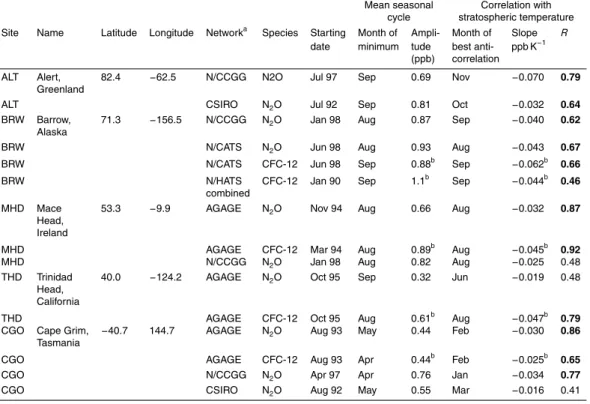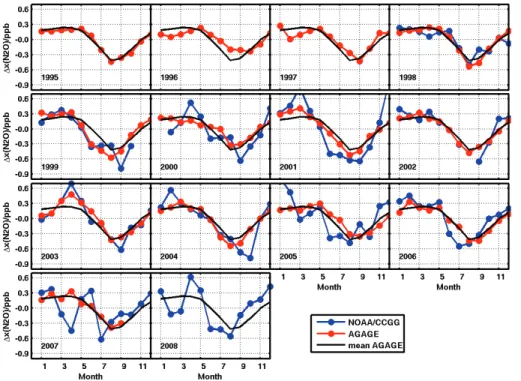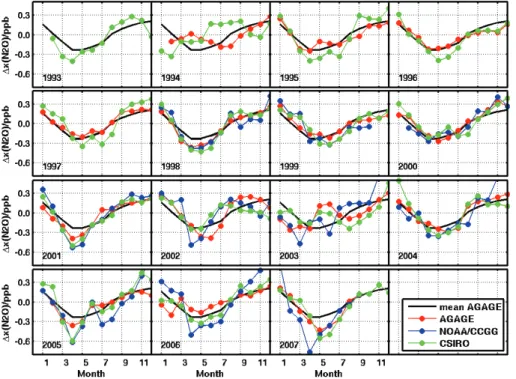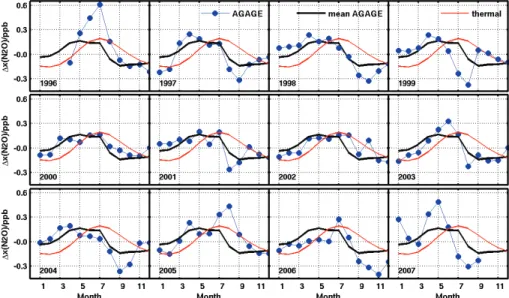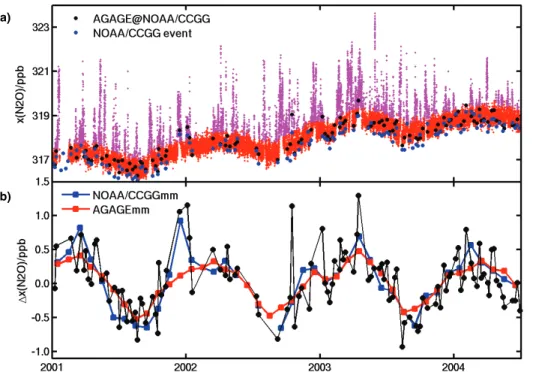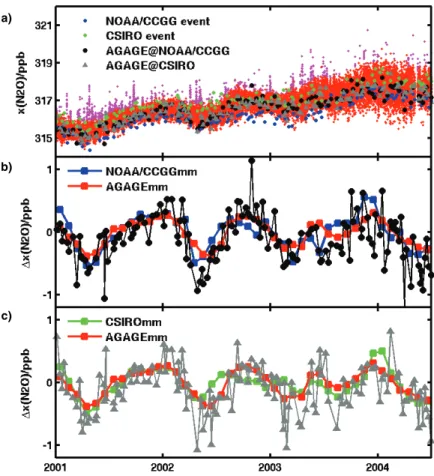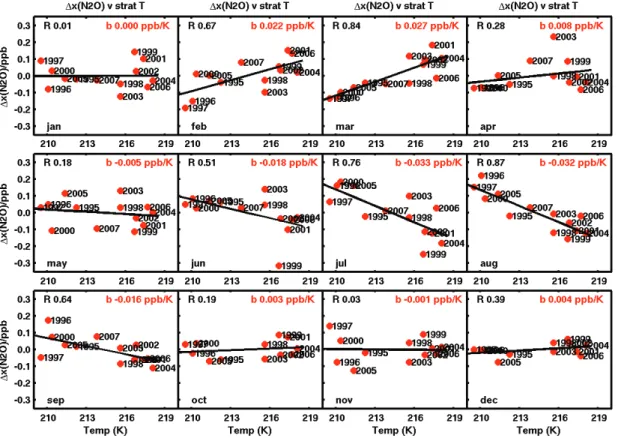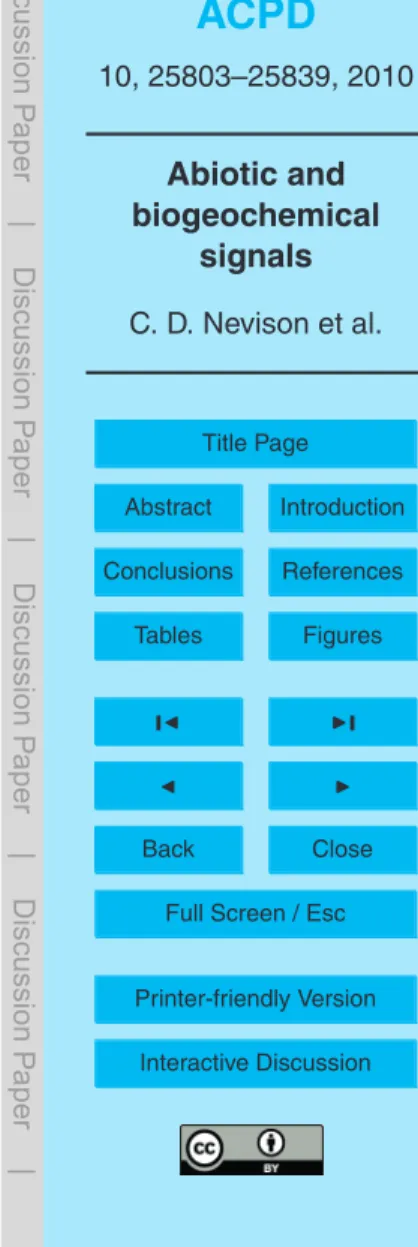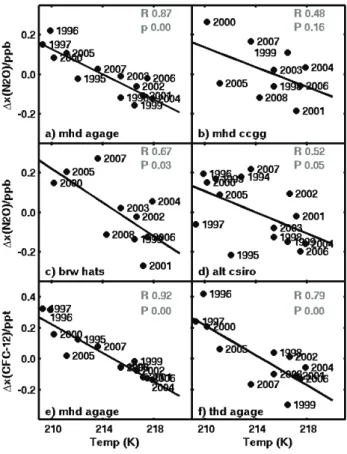ACPD
10, 25803–25839, 2010Abiotic and biogeochemical
signals
C. D. Nevison et al.
Title Page
Abstract Introduction
Conclusions References
Tables Figures
◭ ◮
◭ ◮
Back Close
Full Screen / Esc
Printer-friendly Version Interactive Discussion
Discussion
P
a
per
|
Dis
cussion
P
a
per
|
Discussion
P
a
per
|
Discussio
n
P
a
per
|
Atmos. Chem. Phys. Discuss., 10, 25803–25839, 2010 www.atmos-chem-phys-discuss.net/10/25803/2010/ doi:10.5194/acpd-10-25803-2010
© Author(s) 2010. CC Attribution 3.0 License.
Atmospheric Chemistry and Physics Discussions
This discussion paper is/has been under review for the journal Atmospheric Chemistry and Physics (ACP). Please refer to the corresponding final paper in ACP if available.
Abiotic and biogeochemical signals
derived from the seasonal cycles of
tropospheric nitrous oxide
C. D. Nevison1, E. Dlugokencky2, G. Dutton2,3, J. W. Elkins2, P. Fraser4, B. Hall2, P. B. Krummel4, R. L. Langenfelds4, R. G. Prinn5, L. P. Steele4, and R. F. Weiss6
1
University of Colorado/INSTAAR, Boulder, Colorado, USA
2
NOAA Earth System Research Laboratory, Global Monitoring Division, Boulder, CO 80305, USA
3
University of Colorado, Cooperative Institute for Research in Environmental Sciences, Boulder, CO, USA
4
Centre for Australian Weather and Climate Research/CSIRO Marine and Atmospheric Research, Aspendale, Victoria, 3195 Australia
5
Center for Global Change Science, Department of Earth, Atmospheric, and Planetary Science, Massachusetts Institute of Technology, Cambridge, MA 02139-4307, USA
6
ACPD
10, 25803–25839, 2010Abiotic and biogeochemical
signals
C. D. Nevison et al.
Title Page
Abstract Introduction
Conclusions References
Tables Figures
◭ ◮
◭ ◮
Back Close
Full Screen / Esc
Printer-friendly Version Interactive Discussion
Discussion
P
a
per
|
Dis
cussion
P
a
per
|
Discussion
P
a
per
|
Discussio
n
P
a
per
Received: 17 September 2010 – Accepted: 15 October 2010 – Published: 3 November 2010 Correspondence to: C. D. Nevison (nevison@colorado.edu)
ACPD
10, 25803–25839, 2010Abiotic and biogeochemical
signals
C. D. Nevison et al.
Title Page
Abstract Introduction
Conclusions References
Tables Figures
◭ ◮
◭ ◮
Back Close
Full Screen / Esc
Printer-friendly Version Interactive Discussion
Discussion
P
a
per
|
Dis
cussion
P
a
per
|
Discussion
P
a
per
|
Discussio
n
P
a
per
|
Abstract
Seasonal cycles in the mixing ratios of tropospheric nitrous oxide (N2O) are derived
by detrending long-term measurements made at sites across four global surface mon-itoring networks. These cycles are examined for physical and biogeochemical signals. The detrended monthly data display large interannual variability, which at some sites
5
challenges the concept of a “mean” seasonal cycle. The interannual variability in the seasonal cycle is not always correlated among networks that share common sites. In the Northern Hemisphere, correlations between detrended N2O seasonal minima and
polar winter lower stratospheric temperature provide compelling evidence for a strato-spheric influence, which varies in strength from year to year and can explain much of
10
the interannual variability in the surface seasonal cycle. Even at sites where a strong, competing, regional N2O source exists, such as from coastal upwelling at Trinidad
Head, California, the stratospheric influence must be understood in order to interpret the biogeochemical signal in monthly mean data. In the Southern Hemisphere, de-trended surface N2O monthly means are correlated with polar lower stratospheric
tem-15
perature in months preceding the N2O minimum, suggesting a coherent stratospheric
influence in that hemisphere as well. A decomposition of the N2O seasonal cycle in the extratropical Southern Hemisphere suggests that ventilation of deep ocean water (microbially enriched in N2O) and the stratospheric influx make similar contributions in
phasing, and may be difficult to disentangle. In addition, there is a thermal signal in
20
N2O due to seasonal ingassing and outgassing of cooling and warming surface waters
that is out of phase and thus competes with the stratospheric and ventilation signals. All the seasonal signals discussed above are subtle and are generally better quantified in high-frequency in situ data than in data from weekly flask samples, especially in the Northern Hemisphere. The importance of abiotic influences (thermal, stratospheric
in-25
flux, and tropospheric transport) on N2O seasonal cycles suggests that, at many sites, surface N2O mixing ratio data by themselves are unlikely to provide information about
ACPD
10, 25803–25839, 2010Abiotic and biogeochemical
signals
C. D. Nevison et al.
Title Page
Abstract Introduction
Conclusions References
Tables Figures
◭ ◮
◭ ◮
Back Close
Full Screen / Esc
Printer-friendly Version Interactive Discussion
Discussion
P
a
per
|
Dis
cussion
P
a
per
|
Discussion
P
a
per
|
Discussio
n
P
a
per
powerful if combined with complementary data such as CFC-12 mixing ratios or N2O isotopes.
1 Introduction
Nitrous oxide (N2O) is an important greenhouse gase with a global warming potential about 300 times that of CO2(Forster et al., 2007). It is the major source of NO to the
5
stratosphere and, with the decline of chlorofluorocarbons (CFCs) in the atmosphere, is the dominant ozone-depleting substance emitted in the 21st Century (Ravishankara et al., 2009). The atmospheric N2O concentration has risen from about ∼270 ppb
preindustrially to ∼320 ppb today (MacFarling-Meure et al., 2006), where the units of ppb (parts per billion) are used as a convenient shorthand for mole fraction mixing
10
ratios of nanomoles of N2O per mole of dry air. Some of the best information about
the global budget of atmospheric N2O has been derived from direct atmospheric
mon-itoring, which has allowed the detection of long-term concentration trends and hence the inference of the relative strength of natural versus anthropogenic sources (Weiss et al., 1981; Prinn et al., 2000; Hirsch et al., 2006). Natural microbial production is
15
known to account for about 2/3 of N2O emissions, but partitioning of this production between soils and oceans is uncertain. Anthropogenic sources are primarily associ-ated with agriculture, either directly (e.g., emissions from fertilized fields) or indirectly (e.g., emissions from estuaries polluted with fertilizer runoff) (Forster et al., 2007). It is unclear to what extent anthropogenic emissions can be mitigated in the future, given
20
the need to feed the expanding human population (Kroeze et al., 1999; Mosier et al., 2000).
While large uncertainties remain in bottom-up efforts to quantify N2O sources, the precision of direct atmospheric N2O measurements has improved to the point where
small-amplitude seasonal cycles (currently in the range of 0.1–0.3% of the
back-25
ACPD
10, 25803–25839, 2010Abiotic and biogeochemical
signals
C. D. Nevison et al.
Title Page
Abstract Introduction
Conclusions References
Tables Figures
◭ ◮
◭ ◮
Back Close
Full Screen / Esc
Printer-friendly Version Interactive Discussion
Discussion
P
a
per
|
Dis
cussion
P
a
per
|
Discussion
P
a
per
|
Discussio
n
P
a
per
|
approaches (i.e., atmospheric inversions) have not attempted to resolve seasonality in N2O sources, in large part due to uncertainties over the influence of the flux of N2 O-depleted air from the stratosphere on tropospheric abundances (Hirsch et al., 2006; Huang et al., 2008).
In this paper, we examine the causes of seasonal variability in atmospheric N2O
5
at a range of surface monitoring sites, using data from four different monitoring net-works. Our primary goal is to assess whether seasonal variations in the N2O mixing
ratio are dominated by biogeochemical signals or by abiotic factors that provide little di-rect information about surface sources. We focus in particular on sites in the Southern Hemisphere, where the impact of the stratospheric influx of N2O-depleted air is most
10
uncertain, sites where more than one monitoring network is present, and sites that have contemporaneous CFC-12 measurements. CFC-12 has a similar lifetime and stratospheric sink to N2O, but few remaining surface sources. We therefore assume
that correlated variability in CFC-12 and N2O primarily reflects transport and strato-spheric influences (Nevison et al., 2004, 2007), although this may not always be true,
15
e.g., for air masses coming offthe land in developing countries with active sources of both gases.
2 Methods
2.1 N2O and CFC-12 data
The longest records of atmospheric N2O are available from the Advanced Global
Atmo-20
spheric Gases Experiment (AGAGE) and its predecessors (Prinn et al., 2000) and the NOAA Halocarbons and other Atmospheric Trace Species (HATS) (Thompson et al., 2004) networks. Both AGAGE and NOAA/HATS also monitor CFC-12. While both net-works began in the late 1970s, the instrumentation has evolved over the years and the high precision data needed to reliably detect seasonal cycles in N2O are available
25
ACPD
10, 25803–25839, 2010Abiotic and biogeochemical
signals
C. D. Nevison et al.
Title Page
Abstract Introduction
Conclusions References
Tables Figures
◭ ◮
◭ ◮
Back Close
Full Screen / Esc
Printer-friendly Version Interactive Discussion
Discussion
P
a
per
|
Dis
cussion
P
a
per
|
Discussion
P
a
per
|
Discussio
n
P
a
per
networks include 5 to 6 baseline stations each, making frequent measurements (ev-ery∼40 min) using in situ gas chromatography. The relative precision of the individual
AGAGE measurements is about 0.03% (0.1 ppb) for N2O and slightly less precise for
CFC-12. All AGAGE data are measured on the SIO 2005 calibration scale. Monthly mean values are estimated based on the order of 103 measurements, with local
pol-5
lution events removed. Pollution events are defined based on a 2 sigma deviation from the mean. The NOAA/HATS in situ data are measured using the Chromatograph for Atmospheric Trace Species instruments, abbreviated as CATS. All NOAA data are measured on the NOAA 2006 calibration scale for N2O and the NOAA 2008 scale for
CFC-12.
10
In addition to the in situ data, the NOAA Carbon Cycle Greenhouse Gases (CCGG) group and the Commonwealth Scientific and Industrial Research Organiza-tion (CSIRO) of Australia maintain flask networks, in which duplicate samples are col-lected every∼1 to 2 weeks and shipped for analysis on a central gas chromatograph.
The CSIRO sites are located primarily in the Southern Hemisphere and date from
15
the early 1990s, while NOAA/CCGG began monitoring N2O at∼60 widely distributed
flask sampling sites in 1997. The reproducibility of NOAA/CCGG N2O measurements, based on the mean of absolute values of differences from flask pairs, is 0.4 ppb. The raw measurement precision for the CSIRO flask N2O data, which are measured on
the CSIRO calibration scale, is estimated as+/−0.3 ppb Francey et al., 2003).
Nei-20
ther NOAA/CCGG nor CSIRO provides concurrent CFC-12 measurements, however the NOAA/HATS group measures CFC-12 at a subset of the NOAA/CCGG observing sites. Flask and in situ CFC-12 data, if available, are combined in a product referred to as “NOAA/HATS Combined”. Table 1 lists the names, code letters, networks, and locations of the sites from which data have been analyzed in this paper.
25
2.2 Mean seasonal cycles and interannual variability
fre-ACPD
10, 25803–25839, 2010Abiotic and biogeochemical
signals
C. D. Nevison et al.
Title Page
Abstract Introduction
Conclusions References
Tables Figures
◭ ◮
◭ ◮
Back Close
Full Screen / Esc
Printer-friendly Version Interactive Discussion
Discussion
P
a
per
|
Dis
cussion
P
a
per
|
Discussion
P
a
per
|
Discussio
n
P
a
per
|
quency variability. The remaining high frequency residuals were sorted by month and regressed against several proxies, described below, in an effort to identify causes of interannual variability in the N2O seasonal cycle. A 3rd order polynomial fit was found
to adequately represent the secular trend in data at sites without gaps in the monthly mean record, and thus was used as a placeholder in the 12-month centered running
5
mean at sites with gaps. A “mean” seasonal cycle was calculated by taking the average of the detrended data for all Januaries, Februaries, etc.
2.3 Proxies and indices
The detrended monthly means, sorted by month, were regressed against mean polar (60◦–90◦) lower stratospheric temperature at 100 hPa in winter/spring (January–March
10
in the Northern Hemisphere, September–November in the Southern Hemisphere) from NCEP reanalyses (P. Newman, personal communication), a proxy for the strength of downwelling of N2O- and CFC-depleted air into the lower stratosphere (Nevison et al.,
2007). For the Southern Hemisphere regressions, temperature data from the previ-ous year, relative to that of the N2O data, were used in the regressions for
January-15
August, since the effect of the austral winter stratospheric downwelling was not ex-pected to be felt in the troposphere until September at earliest. In the Southern Hemi-sphere, regressions also were performed between the detrended N2O data and the polar vortex break-up date, calculated from the method used in Nash et al. (1996) from NOAA/DOE Reanalysis-2 data at 450 K (Eric Nash, personal communication). For
20
the Trinidad Head, California site, the N2O monthly anomalies were regressed against the NOAA Pacific Fisheries Environmental Laboratory (PFEL) coastal upwelling index (http://www.pfeg.noaa.gov/products), which is compiled for every 3 degrees of latitude along the Pacific Northwest coastline. For all regressions of detrended N2O monthly means against the proxies described above, the statistical significance of the monthly
25
correlation coefficients was assessed by comparing the calculatedR values to critical
Rvalues determined from a t-table as a function ofN−2 degrees of freedom (see Box
ACPD
10, 25803–25839, 2010Abiotic and biogeochemical
signals
C. D. Nevison et al.
Title Page
Abstract Introduction
Conclusions References
Tables Figures
◭ ◮
◭ ◮
Back Close
Full Screen / Esc
Printer-friendly Version Interactive Discussion
Discussion
P
a
per
|
Dis
cussion
P
a
per
|
Discussion
P
a
per
|
Discussio
n
P
a
per
2.4 Thermal signals
Atmospheric signals due to seasonal ingassing and outgassing associated with the changing solubility of cooling and warming ocean waters were estimated for N2O and
CFC-12. These were calculated from a simulation of the MATCH atmospheric transport model (Mahowald et al., 1997) forced with a mean annual cycle of thermal O2 fluxes
5
calculated based on NCEP heat fluxes (Kalnay et al., 1996) and the formula of Jin et al. (2007). The thermal cycles of N2O and CFC-12 were estimated from the modeled O2 thermal cycles by scaling by the ratio of the temperature derivative of the respective solubility coefficients (Nevison et al., 2005).
3 Results and discussion
10
3.1 Mean annual cycle
The seasonal cycles in N2O are small, with mean amplitudes ranging from about 0.3 to 0.9 ppb (Table 1), which amounts to only∼0.1 to 0.3% of the mean tropospheric mixing ratio of 320 ppb. The late summer minima observed in surface N2O at MHD, BRW
(Figs. 1a, S1) and many other Northern Hemisphere sites are also seen in CFC-12
15
data (Nevison et al., 2004, 2007; Jiang et al., 2007). These minima are consistent with a stratospheric signal in which air depleted in both N2O and CFC-12 descends from
the middle and upper stratosphere during winter due to the Brewer-Dobson circulation, undergoes stratosphere-troposphere exchange (STE), and propagates down to the lower troposphere with a delay of about 3 months (Holton et al., 1995; Nevison et al.,
20
2007; Liang et al., 2008, 2009). Model studies indicate that STE of this N2O- and CFC-depleted air peaks in spring, with maximum injection in the 50◦–60◦N latitude band, although the exact location of maximum injection is likely a model-specific result and may vary seasonally with the position of the jet stream (Gettelman and Sobel, 2000; Liang et al., 2008, 2009).
ACPD
10, 25803–25839, 2010Abiotic and biogeochemical
signals
C. D. Nevison et al.
Title Page
Abstract Introduction
Conclusions References
Tables Figures
◭ ◮
◭ ◮
Back Close
Full Screen / Esc
Printer-friendly Version Interactive Discussion
Discussion
P
a
per
|
Dis
cussion
P
a
per
|
Discussion
P
a
per
|
Discussio
n
P
a
per
|
The late summer minima also reflect tropospheric transport mechanisms, e.g., sum-mer vs. winter differences in convection and boundary layer thickness. Nevison et al. (2007) ran a chemical transport model without stratospheric sinks and still obtained late summer minima in N2O and CFC-12 at some northern sites, due to seasonal variations
in tropospheric transport and circulation. Liang et al. (2008) ran CFC-12 in an AGCM
5
and found that the surface seasonal cycle was dominated by the stratospheric influence after the mid-1990s, but with an increasing contribution from tropospheric transport as one moved from mid to high latitudes. However, in the Southern Hemisphere, neither Nevison et al. nor Liang et al. were able to explain the observed fall minima of the N2O
(Figs. 1b, S2) and CFC-12 seasonal cycles based on surface sources and tropospheric
10
transport alone.
A third abiotic influence on atmospheric N2O data is the thermal signal due to
chang-ing solubility in warmchang-ing and coolchang-ing surface ocean waters. The thermal signal is max-imum in late summer in both hemispheres. It tends to oppose the observed seasonal cycle at most sites, although not at THD (Fig. 2), and thus cannot by itself explain the
15
observed cycle.
3.2 Differences among monitoring networks
N2O data display considerable interannual variability, such that the concept of a “mean” seasonal cycle may not be very meaningful at some sites (Fig. 2). In addition, different monitoring networks that share common sites sometimes observe seasonal cycles that
20
differ substantially in both shape and amplitude (Figs. 1a,b, S1, S2, Table 1). Some of the variability among networks may reflect local meteorology at the time of sampling or data filtering. To evaluate this possibility, we examined, for each month of the sea-sonal cycle, whether the detrended N2O monthly means from different networks that share a common site showed correlated interannual variability. At Mace Head, which
25
ACPD
10, 25803–25839, 2010Abiotic and biogeochemical
signals
C. D. Nevison et al.
Title Page
Abstract Introduction
Conclusions References
Tables Figures
◭ ◮
◭ ◮
Back Close
Full Screen / Esc
Printer-friendly Version Interactive Discussion
Discussion
P
a
per
|
Dis
cussion
P
a
per
|
Discussion
P
a
per
|
Discussio
n
P
a
per
by AGAGE, NOAA/CCGG and the CSIRO flask network (Fig. 1b), the detrended N2O monthly means are significantly correlated among the three networks, although only in∼March–May around the time of the seasonal minimum, withR values around 0.7. At Barrow, Alaska, the detrended N2O monthly means are not significantly correlated between NOAA/CCGG and in situ CATS data (Fig. S1). At the South Pole, the
de-5
trended N2O data are weakly correlated around the time of the May seasonal minimum
among the NOAA/CATS, NOAA/CCGG and CSIRO networks, although withR values only around 0.5 (Fig. S2).
The lack of correlation in detrended N2O data between NOAA/CCGG and the
AGAGE and NOAA/CATS networks at Mace Head and Barrow, respectively, could
re-10
flect limitations specific to NOAA/CCGG data. Alternatively, it could reflect the fact that interannual variability in the N2O seasonal cycle at northern sites is more strongly
influenced by local conditions, including meteorology and pollution events, and data filtering artifacts than at southern sites. At MHD, about 20% of the in situ AGAGE mea-surements are tagged as pollution events compare to only 5% at CGO. When AGAGE
15
data are subsampled at MHD at the time of NOAA/CCGG flask collection, the sub-sampled dataset picks up a number of somewhat erratic features that show up in the NOAA/CCGG data, but that are smoothed out or tagged as pollution events in the full AGAGE dataset (Fig. 3a,b). At CGO, subsampling of the AGAGE data at the time of NOAA/CCGG or CSIRO flask collection can explain some of the differences between
20
the full AGAGE dataset and the two flask networks (Fig. 4). However, it does not appear to be the only factor governing the discrepancies among the networks (Fig. 4b,c). In general, detecting subtle seasonal and interannual signals in N2O data is more difficult for a flask network sampling every 1–2 weeks, with an average flask pair agreement of 0.4 ppb (in the case of NOAA/CCGG), than for an in situ network with a high-frequency
25
ACPD
10, 25803–25839, 2010Abiotic and biogeochemical
signals
C. D. Nevison et al.
Title Page
Abstract Introduction
Conclusions References
Tables Figures
◭ ◮
◭ ◮
Back Close
Full Screen / Esc
Printer-friendly Version Interactive Discussion
Discussion
P
a
per
|
Dis
cussion
P
a
per
|
Discussion
P
a
per
|
Discussio
n
P
a
per
|
3.3 Interannual variations in the seasonal cycle
3.3.1 Northern Hemisphere
In an effort to understand the causes of N2O seasonality, we compared interannual vari-ability in the seasonal cycle to several proxies that offer mechanistic insight. The first of these proxies was mean winter polar lower stratospheric temperature. Interannual
vari-5
ation in the strength of the Brewer-Dobson circulation affects the extent to which warm middle and upper stratospheric air, which is depleted in N2O and CFCs due to
pho-tolysis and oxidation, descends into the polar lower stratosphere, causing temperature to covary with N2O and CFC minimum anomalies. The N2O and CFC minima in turn propagate into the troposphere through stratosphere-troposphere exchange. We
inter-10
pret correlations between polar winter lower stratospheric temperature and detrended tropospheric N2O or CFC seasonal minima as evidence of a stratospheric influence on the tropospheric seasonal cycle. However, we can not rule out the possibility that these correlations might arise if tropospheric N2O and CFC-12 variability is driven by weather
anomalies, e.g., in convection over continents, that in turn correlate with stratospheric
15
temperatures.
When the detrended AGAGE MHD N2O monthly means from Fig. 1a, sorted by
month, are plotted against stratospheric temperature, statistically significant anticor-relations are found in July–September, the months surrounding the August minimum (Fig. 5). Deeper minima occur during warm years, consistent with the stratospheric
20
influence hypothesized above. While the strongestR value occurs in August, a sum-mary of the monthly results shows additional significant positive correlations with strato-spheric temperature for the February-March data, near the time of the N2O maximum
and before one would expect the stratospheric influence from the current year’s Brewer-Dobson circulation to be felt in the troposphere (Fig. 6). These February-March
corre-25
ACPD
10, 25803–25839, 2010Abiotic and biogeochemical
signals
C. D. Nevison et al.
Title Page
Abstract Introduction
Conclusions References
Tables Figures
◭ ◮
◭ ◮
Back Close
Full Screen / Esc
Printer-friendly Version Interactive Discussion
Discussion
P
a
per
|
Dis
cussion
P
a
per
|
Discussion
P
a
per
|
Discussio
n
P
a
per
years (Nevison et al., 2007), resulting in a flatter curve being subtracted from the raw monthly mean N2O data in warm years.
In addition to the AGAGE N2O correlations at MHD, Fig. 7 and Table 1 show
sig-nificant correlations between mean winter polar lower stratospheric temperature and the detrended N2O seasonal minima at ALT and BRW for CSIRO and CATS data,
re-5
spectively. At MHD, NOAA/CCGG detrended N2O minima show a weak, although not
statistically significant, anticorrelation with stratospheric temperature (Fig. 7b). Fig-ure 3b suggests that the difference between the AGAGE and NOAA/CCGG results at MHD may be a sampling issue, in which the relatively infrequent weekly NOAA/CCGG flask samples intersect with pollution influences and noise due to atmospheric
variabil-10
ity in the N2O data to obscure subtle interannual signals. In support of this hypothesis, the AGAGE N2O data at MHD are themselves only weakly anticorrelated with
strato-spheric temperature when pollution-filtered monthly means are replaced with unfiltered data, with theRvalues for the detrended August monthly means dropping from 0.87 to 0.49.
15
At MHD and THD (AGAGE data), significant anticorrelations are observed between stratospheric temperature and detrended CFC-12 seasonal minima (Fig. 7e,f). At BRW, the detrended NOAA/CATS CFC-12 minima are correlated with stratospheric temperature, although the correlation is not as robust as for NOAA/CATS N2O. The
NOAA/HATS combined in situ/flask CFC-12 minima at BRW are also weakly but
signif-20
icantly correlated with stratospheric temperature for time series beginning in the 1990s and extending through the present. At MHD, where the strongest correlations with stratospheric temperature are observed for both AGAGE N2O and CFC-12 minima, the regressions yield slopes (in ppb/K) with a ratio of about 0.7 (where CFC-12 has been normalized to N2O units by multiplying by [x(N2O)/ppb]/[x(CFC-12)/ppt]). The
25
0.7 ratio is notably similar to the Volk et al. (1996) slope of normalized N2O vs. CFC-12 data measured near the tropopause.
ACPD
10, 25803–25839, 2010Abiotic and biogeochemical
signals
C. D. Nevison et al.
Title Page
Abstract Introduction
Conclusions References
Tables Figures
◭ ◮
◭ ◮
Back Close
Full Screen / Esc
Printer-friendly Version Interactive Discussion
Discussion
P
a
per
|
Dis
cussion
P
a
per
|
Discussion
P
a
per
|
Discussio
n
P
a
per
|
September), although additional correlations in the months surrounding the minimum also occur in some cases. The correlation coefficients in Fig. 7 and Table 1 indicate that the interannual variability in the stratospheric signal can account for anywhere between
∼75% (at MHD) and∼25% (at ALT) of the variability in the detrended minima. Noise in
the data, biogeochemical sources and tropospheric transport variability, especially at
5
high latitudes, may account for the remainder.
Trinidad Head, California is an interesting case in which the detrended CFC-12 monthly means are significantly anticorrelated to stratospheric temperature in August, but the detrended N2O monthly means are not (Fig. 8a,c). Since N2O data at THD
are known to be influenced by ventilation of N2O-enriched deepwater during coastal
10
upwelling events (Lueker et al., 2003), we performed additional regressions of THD detrended N2O data against the coastal upwelling index for the Pacific Northwest.
Cor-relations of R=0.45 to 0.66 were found in April–September (the upwelling season), with more positive N2O values occurring during years of strong upwelling (Fig. 8b). A multivariate regression of detrended N2O data against the upwelling index and
15
stratospheric temperature improved these correlations to R=0.64 to 0.82 for April– September (Fig. 8d). Statistically significant correlations were obtained from the multi-variate regression using the coastal upwelling indices at 42◦N, 45◦N and 48◦N (THD is at 40◦N), with best results obtained for the 45◦N index. The results at THD indicate that sites located near strong regional N2O sources are also substantially affected by
20
the stratospheric influx and that the latter influence must be accounted for in order to best interpret the biogeochemical signal in monthly mean data.
3.3.2 Southern Hemisphere
In previous studies, the stratospheric influence on N2O and CFC-12 has been less clear in the Southern Hemisphere than in the Northern Hemisphere. Two atmospheric
gen-25
ACPD
10, 25803–25839, 2010Abiotic and biogeochemical
signals
C. D. Nevison et al.
Title Page
Abstract Introduction
Conclusions References
Tables Figures
◭ ◮
◭ ◮
Back Close
Full Screen / Esc
Printer-friendly Version Interactive Discussion
Discussion
P
a
per
|
Dis
cussion
P
a
per
|
Discussion
P
a
per
|
Discussio
n
P
a
per
although both models predicted a coherent signal in summer in the Northern Hemi-sphere (Nevison et al., 2004; Ishijima et al., 2010). In contrast, the GEOS CCM model predicted coherent cycles in CFC-12 with autumn minima (Liang et al., 2008), although the amplitudes were about 50% smaller than the corresponding Northern Hemisphere amplitudes. Isotopic evidence, i.e., seasonal enrichment in15N-N2O characteristic of
5
stratospheric air, also provides support for a stratospheric signal in tropospheric N2O
at CGO (Park et al., 2008). In addition, N2O and CFC-12 seasonal cycles and
inter-annual growth rate anomalies at Cape Grim are generally well correlated, suggesting a common influence such as the stratospheric influx (Nevison et al., 2004, 2007).
Stratosphere-troposphere exchange (STE) in the Southern Hemisphere is not as
10
well studied as in the Northern Hemisphere, although it is thought to be coupled to a Brewer-Dobson circulation with weaker, less strongly seasonal descent into the win-ter pole than in the Northern Hemisphere (Holton et al., 1995). The polar vortex is also more stable and persistent in the Southern Hemisphere, which traps N2O and CFC-depleted air in the polar lower stratosphere longer and hinders exchange with
15
mid-latitudes, where most STE occurs, until late spring or early summer (Nevison et al., 2007). The late polar vortex breakup, combined with a lower-stratosphere-to-surface propagation time of several months for the stratospheric signal, may explain the later minima (autumn vs. late summer) observed in the Southern vs. Northern Hemispheres (Nevison et al., 2004; Liang et al., 2008).
20
The detrended AGAGE N2O monthly means at Cape Grim (Fig. 1b), sorted by month and plotted against austral polar lower stratospheric temperature from the previous winter-spring, show statistically significant anticorrelations in January–February, with more negative values occurring during warm years. By May–June, however, the de-trended N2O data become positively correlated to stratospheric temperature (Fig. 9).
25
ACPD
10, 25803–25839, 2010Abiotic and biogeochemical
signals
C. D. Nevison et al.
Title Page
Abstract Introduction
Conclusions References
Tables Figures
◭ ◮
◭ ◮
Back Close
Full Screen / Esc
Printer-friendly Version Interactive Discussion
Discussion
P
a
per
|
Dis
cussion
P
a
per
|
Discussion
P
a
per
|
Discussio
n
P
a
per
|
stratospheric temperature are found for AGAGE CFC-12 (Fig. 10a).
In an effort to better understand these findings, and because the N2O minimum at
CGO varies from February-June in individual years, most commonly occuring in April or May (Fig. 1b), we regressed the month of the AGAGE N2O minimum against polar vortex break-up date (ranging from mid-November to the end of December) and found
5
that earlier minima tended to occur in years with early vortex breakup and later minima in years with late breakup (R=0.75). However, warmer stratospheric temperatures are themselves significantly correlated with earlier vortex breakup (R=0.79), such that the two indices provide more or less redundant, rather than independent, predictive capability for the detrended N2O monthly means.
10
The NOAA/CCGG flask data at CGO show correlation patterns with stratospheric temperature that are similar to those seen by AGAGE, although the correlations are statistically significant only in January (Fig. 10d, e). In addition, both the NOAA/CCGG and CSIRO flask networks show correlation patterns similar to those seen at CGO by AGAGE at many of their other extratropical southern sites (Fig. 11, Table 1). In
15
most cases, the anticorrelations are strongest in the months preceding the N2O
mini-mum, which typically occurs in May, with the exception of Macquarie Island, where the anticorrelation is strongest in May. At the South Pole, neither the CSIRO, CATS nor NOAA/CCGG networks shows statistically significant correlations between detrended N2O data and stratospheric temperature, although there is a hint of an anticorrelation
20
in January–February in detrended CATS CFC-12 data (Table 1). Since STE of N2
O-depleted air takes place mainly at midlatitudes (Ishijima et al., 2010), the South Pole site is more poorly situated then the other sites to detect the stratospheric signal.
The mixed results in Figs. 9–11 suggest that the stratospheric influx following polar vortex breakup does exert a coherent influence on the N2O seasonal cycle, but that this
25
ACPD
10, 25803–25839, 2010Abiotic and biogeochemical
signals
C. D. Nevison et al.
Title Page
Abstract Introduction
Conclusions References
Tables Figures
◭ ◮
◭ ◮
Back Close
Full Screen / Esc
Printer-friendly Version Interactive Discussion
Discussion
P
a
per
|
Dis
cussion
P
a
per
|
Discussion
P
a
per
|
Discussio
n
P
a
per
(Figs. 2, 8).
Like Trinidad Head, monitoring sites in the Southern Ocean region are influenced by ventilation of oceanic, microbially-produced N2O. This is especially true of sites
situated in the heart of the Antarctic Circumpolar Current (Orsi et al., 1995), between
∼50◦–60◦S, where strong winds and upwelling lead to deep ventilation of N2O-enriched
5
subsurface waters . Nevison et al. (2005) hypothesized that the N2O seasonal cycle at
Cape Grim can be decomposed into comparable contributions from ocean ventilation, the stratospheric influx, and an abiotic thermal signal due to warming and cooling of surface waters (Fig. 12a). The stratospheric signal in Fig. 12a is estimated based on the observed, normalized CFC-12 cycle at CGO multiplied by a scaling factor which is
10
uncertain, but which we assign a best guess value of 0.7 based on the discussion in Sect. 3.3.1.
Unlike THD, where the thermal signal is in phase with the summer upwelling N2O
source, ventilation of Southern Ocean waters occurs during the breakdown of the sea-sonal thermocline in fall and winter, and thus opposes the thermal signal. In Fig. 12b,
15
the thermally-corrected N2O cycle, i.e., subtracting the estimated thermal signal from
the observed “mean” seasonal cycle, yields a cycle that closely resembles the ob-served CFC-12 cycle. (CFC-12 also experiences thermal ingassing and outgassing, but is 8 times less soluble than N2O, such that the thermal correction has little impact
on its cycle (Fig. 12b).) The ocean ventilation and stratospheric signals are roughly
20
coincident, with the former a positive signal peaking in early fall and the latter a neg-ative signal peaking in spring, making the two signals difficult to distinguish based on mixing ratio data alone. Indeed, the possibility that the thermally-corrected N2O cycle in Fig. 12b is primarily or entirely due to the stratospheric influx with no influence from ocean ventilation cannot be ruled out, although this is inconsistent with evidence from
25
atmospheric O2/N2 data and ocean biogeochemistry models (Jin and Gruber, 2003; Nevison et al., 2005).
ACPD
10, 25803–25839, 2010Abiotic and biogeochemical
signals
C. D. Nevison et al.
Title Page
Abstract Introduction
Conclusions References
Tables Figures
◭ ◮
◭ ◮
Back Close
Full Screen / Esc
Printer-friendly Version Interactive Discussion
Discussion
P
a
per
|
Dis
cussion
P
a
per
|
Discussion
P
a
per
|
Discussio
n
P
a
per
|
may be stronger at sites further poleward, in the upwelling region. We tested this hypothesis (following the example at THD) by regressing detrended N2O monthly mean flask data at several Southern Hemisphere sites against a multivariate combination of stratospheric temperature and zonally-averaged NCEP wind speed or windstress curl at the latitude band of the site (Kalnay et al., 1996). Although no significant correlations
5
were found, a more judicious or focused proxy for ocean ventilation, combined with an in situ N2O record at a site within the upwelling region, arguably might yield better
results. In addition, it may be necessary to account for interannual variability in the thermal signal, which directly competes with the ventilation signal.
4 Conclusions
10
Correlations between detrended tropospheric N2O monthly mean data, sorted by month, and various interannually-varying proxies, including polar lower stratospheric temperature, polar vortex breakup date and coastal upwelling indices, are used to help identify the mechanisms that cause interannual variability in the N2O seasonal cycle. In the months surrounding the N2O seasonal minimum, the detrended N2O data are
15
significantly anti-correlated with winter polar lower stratospheric temperature at a num-ber of Northern Hemisphere surface monitoring sites, with deeper minima occurring in warm years, providing strong empirical evidence that these seasonal cycles bear a stratospheric influence. At Trinidad Head, California, detrended N2O monthly means
in summer are weakly correlated to the index for coastal upwelling, which ventilates
20
N2O-enriched deepwater to the atmosphere, but more strongly correlated after the
stratospheric influence is accounted for using a multivariate regression against both stratospheric temperature and the coastal upwelling index. Monitoring sites in the ex-tratropical Southern Hemisphere, where the stratospheric influence on surface N2O
has been more difficult to establish in previous studies, also show anti-correlations
25
ACPD
10, 25803–25839, 2010Abiotic and biogeochemical
signals
C. D. Nevison et al.
Title Page
Abstract Introduction
Conclusions References
Tables Figures
◭ ◮
◭ ◮
Back Close
Full Screen / Esc
Printer-friendly Version Interactive Discussion
Discussion
P
a
per
|
Dis
cussion
P
a
per
|
Discussion
P
a
per
|
Discussio
n
P
a
per
seasonal minimum as in the northern hemisphere, but rather are stronger in months preceding the minimum. Southern Ocean sites also are likely influenced by oceanic thermal and biological ventilation signals, but these influences are difficult to prove using the methodology of this study. N2O seasonal cycles can vary strongly year to
year, making a “mean” cycle difficult to define at some sites, especially those subject
5
to competing influences from various interannually-varying sources and sinks. Among networks that share a common site, interannual variability in detrended N2O monthly
means is not necessarily well correlated, especially in the Northern Hemisphere. In part, this is a sampling issue, with weekly flask networks less able to detect subtle in-terannual signals and filter out noise due to atmospheric variability than more frequently
10
sampled in situ networks. Due to the various abiotic influences on N2O seasonal cycles, including thermal oceanic in and outgassing, stratospheric influx, and tropo-spheric transport, sites that measure a complementary tracer, e.g.,15N-N2O or
CFC-12, that helps separate transport and stratospheric influences from soil and oceanic biogeochemical source signals are more likely to provide insight into seasonality in
15
N2O sources.
Supplementary material related to this article is available online at: http://www.atmos-chem-phys-discuss.net/10/25803/2010/
acpd-10-25803-2010-supplement.pdf.
Acknowledgement. CDN acknowledges support from NASA grant NNX08AB48G and thanks
20
Paul Newman and Eric Nash for stratospheric data and Qing Liang and Ralph Keeling for help-ful comments. The authors are deeply gratehelp-ful to the many people, from many organisations around the world, who have contributed to the production of the excellent N2O datasets that have made this study possible. These include the people who diligently collect flask air sam-ples, those who analyze the flask samsam-ples, and those staffwho maintain the optimal operation
25
ACPD
10, 25803–25839, 2010Abiotic and biogeochemical
signals
C. D. Nevison et al.
Title Page
Abstract Introduction
Conclusions References
Tables Figures
◭ ◮
◭ ◮
Back Close
Full Screen / Esc
Printer-friendly Version Interactive Discussion
Discussion
P
a
per
|
Dis
cussion
P
a
per
|
Discussion
P
a
per
|
Discussio
n
P
a
per
|
References
Forster, P., Ramaswamy, V., Artaxo, P., Berntsen, T., Betts, R., Fahey, D. W., Haywood, J., Lean, J., Lowe, D. C., Myhre, G., Nganga, J., Prinn, R., Raga, G., Schulz, M., and Van Dorland, R.: Changes in atmospheric constituents and in radiative forcing, in: Climate Change 2007: The Physical Science Basis. Contribution of Working Group I to the Fourth
As-5
sessment Report of the Intergovernmental Panel on Climate Change. Cambridge University Press Cambridge, UK and New York, NY, USA, 2007.
Francey, R. J., Steele, L. P., Spencer, D. A., Langenfelds, R. L., Law, R. M., Krummel, P. B., Fraser, P. J., Etheridge, D. M., Derek, N., Coram, S. A., Cooper, L. N., Allison, C. E., Porter, L., and Baly, S.: The CSIRO (Australia) measurement of greenhouse gases in the global
atmo-10
sphere, in: Baseline Atmospheric Program Australia 1999–2000, edited by: Tindale, N. W., Derek, N., and Fraser, P. J., Bureau of Meteorology and CSIRO Atmospheric Research, Melbourne, Australia, 42–53, 2003.
Glatthor, N., et al.: Mixing processes duing the Antarctic vortex split in September–October 2002 as inferred from source gas and ozone distributions from ENVISAT-MIPAS, J. Atmos.
15
Sci., 62(3), 787–800, 2005.
Gettelman, A. and Sobel, A. H.: Direct diagnoses of stratosphere-troposphere exchange, J. At-mos. Sci., 57(1), 3–16, 2000.
Hirsch, A. I., Michalak, A. M., Bruhwiler, L. M., Peters, W., Dlugokencky, E. J., and Tans, P. P.: Inverse modeling estimates of the global nitrous oxide surface flux from 1998–2001, Global
20
Biogeochem. Cy., 20, GB1008, 2006.
Holton, J. R., Haynes, P. H., McIntyre, M. E., Douglass, A. R., Rood, R. B., and Pfister, L.: Stratosphere-troposphere exchange, Rev. Geophys., 33(4), 403–439, 1995.
Huang, J., Golombek, A., Prinn, R., Weiss, R., Fraser, P., Simmonds, P., Dlugokencky, E. J., Hall, B., Elkins, J., Steele, P., Langenfelds, R., Krummel, P., Dutton, G., and Porter, L.:
Esti-25
mation of regional emissions of nitrous oxide from 1997 to 2005 using multinetwork measure-ments, a chemical transport model, and an inverse method, J. Geophys. Res. 113, D17313, doi:10.1029/2007JD009381, 2008.
Ishijima, K., Nakazawa, T., Sugawara, S., Aoki, S., and Saeki, T.: Concentration variations of tropospheric nitrous oxide over Japan, Geophys. Res. Lett., 28(1), 171–174, 2001.
30
ACPD
10, 25803–25839, 2010Abiotic and biogeochemical
signals
C. D. Nevison et al.
Title Page
Abstract Introduction
Conclusions References
Tables Figures
◭ ◮
◭ ◮
Back Close
Full Screen / Esc
Printer-friendly Version Interactive Discussion
Discussion
P
a
per
|
Dis
cussion
P
a
per
|
Discussion
P
a
per
|
Discussio
n
P
a
per
the seasonal cycle of nitrous oxide in the troposphere as deduced from aircraft observations and model simulations, J. Geophys. Res., doi:10.1029/2009JD013322, 2010.
Jiang, X., Ku, W. L., Shia, R.-L., Li, Q., Elkins, J. W., Prinn, R. G., and Yung, Y. L.: Seasonal cycle of N2O: analysis of data, Global Biogeochem. Cy., 21, GB1006, 2007.
Jin, X. and Gruber, N.: Offsetting the radiative benefit of ocean iron fertilization by enhancing
5
N2O emissions, Geophys. Res. Lett., 30(24), 2249, 2003.
Jin, X., Najjar, R. G., Louanchi, F., and Doney, S. C.: A modeling study of the seasonal oxygen budget of the global ocean, J. Geophys. Res., 112, C05017, doi:10.1029/2006JC003731, 2007.
Kalnay, E., Kanamitsu, M., Kistler, R., Collins, W., Deaven, D., et al.: The NMC/NCAR 40-year
10
reanalysis project, B. Am. Meteorol. Soc., 77, 437–471, 1996.
Kroeze, C., Mosier, A., and Bouwman, L.: Closing the global N2O budget: A retrospective analysis 1500–1994, Global Biogeochem. Cy., 13, 1–8, 1999.
Liang, Q., Stolarski, R. S., Douglass, A. R., Newman, P. A., and Nielsen, J. E.: Evaluation of emissions and transport of CFCs using surface observations and their seasonal
cy-15
cles and the GEOS CCM simulation with emissions-based forcing, J. Geophys. Res., 113, doi:10.1029/2007JD009617, 2008.
Liang, Q., Douglass, A. R., Duncan, B. N., Stolarski, R. S., and Witte, J. C.: The governing processes and timescales of stratosphere-to-troposphere transport and its contribution to ozone in the Arctic troposphere, Atmos. Chem. Phys., 9, 3011–3025,
doi:10.5194/acp-9-20
3011-2009, 2009.
Liao, T., Camp, C. D., and Yung, Y. L.: The seasonal cycle of N2O, Geophys. Res. Lett., 31, 17108, 2004.
Levin, I. P., Cias, P., Langenfelds, R., Schmidt, M., Ramonet, M., et al.: Three years of trace gas observations over the EuroSiberian domain derived from aircraft sampling – a concerted
25
action, Tellus, 54B, 696–712, 2002.
Lueker, T. J., Walker, S. J., Vollmer, M. K., Keeling, R. F., Nevison, C. D., and Weiss, R. F.: Coastal upwelling air-sea fluxes revealed in atmospheric observations of O2/N2, CO2 and N2O, Geophys. Res. Lett., 30, 1292, 2003.
MacFarling Meure, C., Etheridge, D. M., Trudinger, C. M., Steele, L. P., Langenfelds, R. L., van
30
Ommen, T., Smith, A., and Elkins, J. W.: Law Dome CO2, CH4, and N2O ice core records extended to 2000 years BP, Geophys. Res. Lett., 33, L14810, 2006.
ACPD
10, 25803–25839, 2010Abiotic and biogeochemical
signals
C. D. Nevison et al.
Title Page
Abstract Introduction
Conclusions References
Tables Figures
◭ ◮
◭ ◮
Back Close
Full Screen / Esc
Printer-friendly Version Interactive Discussion
Discussion
P
a
per
|
Dis
cussion
P
a
per
|
Discussion
P
a
per
|
Discussio
n
P
a
per
|
radon-222 to the remote troposphere using the Model of Atmospheric Transport and Chem-istry and assimilated winds from ECMWF and the National Center for Environmental Predic-tion/NCAR, J. Geophys. Res., 102, 28139–28151, 1997.
Mosier, A. R., Duxbury, J. M., Freney, J. R., Heinemeyer, O., and Minami, K.: Assessing and mitigating N2O emissions from agricultural soils, Climatic Change, 40, 7–38, 2000.
5
Nevison, C. D., Kinnison, D. E., and Weiss, R. F.: Stratospheric Influence on the tropospheric seasonal cycles of nitrous oxide and chlorofluorocarbons, Geophys. Res. Lett., 31(20), L20104, 2004.
Nevison, C. D., Keeling, R. F., Weiss, R. F., Popp, B. N., Jin, X., Fraser, P. J., Porter, L. W., and Hess, P. G.: Southern Ocean ventilation inferred from seasonal cycles of atmospheric N2O
10
and O2/N2at Cape Grim, Tasmania, Tellus, 57B, 218–229, 2005.
Nevison, C. D., Mahowald, N. M., Weiss, R. F., and Prinn, R. G.: Interannual and seasonal variability in atmospheric N2O, Global Biogeochem. Cy., 21, GB3017, 2007.
Orsi, A. H., Whitworth III, T., and Nowlin Jr., W. D.: On the meridional extent and fronts of the Antarctic Circumpolar Current, Deep-Sea Res. Pt. I, 42(5), 651–673, 1995.
15
Park, S., Boering, K. A., and Etheridge, D. M.: Trends, seasonal cycles, and interannual variabil-ity in the isotopic composition of nitrous oxide between 1940 and 2008, Eos Trans., 89(53), Abstract A21A-0125, 2008.
Prinn, R. G., Weiss, R. F., Fraser, P. J., Simmonds, P. G., Cunnold, D. M., Alyea, F. N., O’Doherty, S., Salameh, P., Miller, B. R., Huang, J., Wang, R. H. J., Hartley, D. E., Harth, C.,
20
Steele, L. P., Sturrock, G., Midgley, P. M., and McCulloch, A.: A history of chemically and radiatively important gases in air deduced from ALE/GAGE/AGAGE, J. Geophy. Res., 105(D14), 17751–17792, 2000.
Ravishankara, A. R., Daniel, J. S., and Portmann, R. W.: Nitrous oxide (N2O): The dom-inant ozone depleting substance emitted in the 21st century, Science, 326, 123–125,
25
doi:10.1126/science.1176985, 2009.
Sokal, R. R. and Rohlf, F. J.: Biometry, W. H. Freeman, New York, USA, 859 pp., 1981.
Thompson, T. M., Elkins, J. W., Hall, B., et al.: Halocarbons and other atmospheric trace species, in: Climate Diagnostics Laboratory Summary Report #27, 2002–2003, edited by: Schnell, R. C., Buggle, A.-M., and Rossson, R. M., US Department of Commerce, National
30
Oceanic and Atmospheric Administration, Boulder, Colorado, 2004.
ACPD
10, 25803–25839, 2010Abiotic and biogeochemical
signals
C. D. Nevison et al.
Title Page
Abstract Introduction
Conclusions References
Tables Figures
◭ ◮
◭ ◮
Back Close
Full Screen / Esc
Printer-friendly Version Interactive Discussion
Discussion
P
a
per
|
Dis
cussion
P
a
per
|
Discussion
P
a
per
|
Discussio
n
P
a
per
Chan, K. R.: Quantifying transport between the tropical and mid-latitude lower stratosphere, Science, 272, 1763–1768, 1996.
ACPD
10, 25803–25839, 2010Abiotic and biogeochemical
signals
C. D. Nevison et al.
Title Page
Abstract Introduction
Conclusions References
Tables Figures
◭ ◮
◭ ◮
Back Close
Full Screen / Esc
Printer-friendly Version Interactive Discussion
Discussion
P
a
per
|
Dis
cussion
P
a
per
|
Discussion
P
a
per
|
Discussio
n
P
a
per
|
Table 1. Correlations between N2O seasonal minimum anomalies and mean polar (60◦–90◦) lower stratospheric (at 100 hPa) temperature for January–March (Northern Hemisphere) or September–November (Southern Hemisphere). Bold type in final column indicates statistically significant correlations (p≤0.05).
Mean seasonal Correlation with cycle stratospheric temperature Site Name Latitude Longitude Networka Species Starting Month of Ampli- Month of Slope R
date minimum tude best anti- ppb K−1
(ppb) correlation
ALT Alert, 82.4 −62.5 N/CCGG N2O Jul 97 Sep 0.69 Nov −0.070 0.79
Greenland
ALT CSIRO N2O Jul 92 Sep 0.81 Oct −0.032 0.64
BRW Barrow, 71.3 −156.5 N/CCGG N2O Jan 98 Aug 0.87 Sep −0.040 0.62
Alaska
BRW N/CATS N2O Jun 98 Aug 0.93 Aug −0.043 0.67
BRW N/CATS CFC-12 Jun 98 Sep 0.88b Sep −0.062b 0.66
BRW N/HATS CFC-12 Jan 90 Sep 1.1b Sep −0.044b 0.46
combined
MHD Mace 53.3 −9.9 AGAGE N2O Nov 94 Aug 0.66 Aug −0.032 0.87
Head, Ireland
MHD AGAGE CFC-12 Mar 94 Aug 0.89b Aug −0.045b 0.92
MHD N/CCGG N2O Jan 98 Aug 0.82 Aug −0.025 0.48
THD Trinidad 40.0 −124.2 AGAGE N2O Oct 95 Sep 0.32 Jun −0.019 0.48
Head, California
THD AGAGE CFC-12 Oct 95 Aug 0.61b Aug −0.047b 0.79
CGO Cape Grim, −40.7 144.7 AGAGE N2O Aug 93 May 0.44 Feb −0.030 0.86
Tasmania
CGO AGAGE CFC-12 Aug 93 Apr 0.44b Feb −0.025b 0.65
CGO N/CCGG N2O Apr 97 Apr 0.76 Jan −0.034 0.77
ACPD
10, 25803–25839, 2010Abiotic and biogeochemical
signals
C. D. Nevison et al.
Title Page
Abstract Introduction
Conclusions References
Tables Figures
◭ ◮
◭ ◮
Back Close
Full Screen / Esc
Printer-friendly Version Interactive Discussion
Discussion
P
a
per
|
Dis
cussion
P
a
per
|
Discussion
P
a
per
|
Discussio
n
P
a
per
Table 1.Continued.
Mean seasonal Correlation with cycle stratospheric temperature Site Name Latitude Longitude Networka Species Starting Month of Ampli- Month of Slope R
date minimum tude best anti- ppb K−1
(ppb) correlation
CRZ Crozet −46.4 51.8 N/CCGG N2O Mar 97 Apr 0.72 Feb −0.039 0.68
Island
TDF Tierra −54.5 −68.5 N/CCGG N2O Jun 97 May 0.78 Feb −0.038 0.77
del Fuego
MQA Macquarie −54.5 159.0 CSIRO N2O Mar 92 May 0.56 May −0.068 0.75
Island
PSA Palmer −64.9 −64.0 N/CCGG N2O Apr 97 May 0.86 Mar −0.027 0.73
Station
CYA Casey −66.3 110.5 CSIRO N2O Nov 96 May 0.67 Apr −0.023 0.55
Station
MAA Mawson −67.6 62.9 CSIRO N2O Mar 92 May 0.43 Mar −0.019 0.31
SYO Syowa −69.0 39.6 N/CCGG N2O Dec 95 Jun 0.80 Jan −0.032 0.67
HBA Halley Bay −75.6 −26.4 N/CCGG N2O Feb 96 Apr 0.81 Mar −0.025 0.62
SPO South Pole −90.0 −26.5 N/CCGG N2O Jan 97 May 0.75 Mar −0.021 0.48
SPO CSIRO N2O Jan 92 May 0.65 Mar −0.018 0.39
SPO N/CATS N2O Feb 98 May 0.53 Feb −0.011 0.46
SPO N/CATS CFC-12 Mar 98 Apr 0.57b Feb −0.044b 0.49
aNOAA/CCGG, NOAA/HATS and NOAA/CATS abbreviated as N/CCGG, N/HATS and N/CATS; bCFC-12 slopes and mean seasonal amplitudes are normalized to N
ACPD
10, 25803–25839, 2010Abiotic and biogeochemical
signals
C. D. Nevison et al.
Title Page
Abstract Introduction
Conclusions References
Tables Figures
◭ ◮
◭ ◮
Back Close
Full Screen / Esc
Printer-friendly Version Interactive Discussion
Discussion
P
a
per
|
Dis
cussion
P
a
per
|
Discussion
P
a
per
|
Discussio
n
P
a
per
|
ACPD
10, 25803–25839, 2010Abiotic and biogeochemical
signals
C. D. Nevison et al.
Title Page
Abstract Introduction
Conclusions References
Tables Figures
◭ ◮
◭ ◮
Back Close
Full Screen / Esc
Printer-friendly Version Interactive Discussion
Discussion
P
a
per
|
Dis
cussion
P
a
per
|
Discussion
P
a
per
|
Discussio
n
P
a
per
ACPD
10, 25803–25839, 2010Abiotic and biogeochemical
signals
C. D. Nevison et al.
Title Page
Abstract Introduction
Conclusions References
Tables Figures
◭ ◮
◭ ◮
Back Close
Full Screen / Esc
Printer-friendly Version Interactive Discussion
Discussion
P
a
per
|
Dis
cussion
P
a
per
|
Discussion
P
a
per
|
Discussio
n
P
a
per
|
ACPD
10, 25803–25839, 2010Abiotic and biogeochemical
signals
C. D. Nevison et al.
Title Page
Abstract Introduction
Conclusions References
Tables Figures
◭ ◮
◭ ◮
Back Close
Full Screen / Esc
Printer-friendly Version Interactive Discussion
Discussion
P
a
per
|
Dis
cussion
P
a
per
|
Discussion
P
a
per
|
Discussio
n
P
a
per
a)
b)
ACPD
10, 25803–25839, 2010Abiotic and biogeochemical
signals
C. D. Nevison et al.
Title Page
Abstract Introduction
Conclusions References
Tables Figures
◭ ◮
◭ ◮
Back Close
Full Screen / Esc
Printer-friendly Version Interactive Discussion
Discussion
P
a
per
|
Dis
cussion
P
a
per
|
Discussion
P
a
per
|
Discussio
n
P
a
per
|
a)
b)
c)
ACPD
10, 25803–25839, 2010Abiotic and biogeochemical
signals
C. D. Nevison et al.
Title Page
Abstract Introduction
Conclusions References
Tables Figures
◭ ◮
◭ ◮
Back Close
Full Screen / Esc
Printer-friendly Version Interactive Discussion
Discussion
P
a
per
|
Dis
cussion
P
a
per
|
Discussion
P
a
per
|
Discussio
n
P
a
per
ACPD
10, 25803–25839, 2010Abiotic and biogeochemical
signals
C. D. Nevison et al.
Title Page
Abstract Introduction
Conclusions References
Tables Figures
◭ ◮
◭ ◮
Back Close
Full Screen / Esc
Printer-friendly Version Interactive Discussion
Discussion
P
a
per
|
Dis
cussion
P
a
per
|
Discussion
P
a
per
|
Discussio
n
P
a
per
|
a)
b)
ACPD
10, 25803–25839, 2010Abiotic and biogeochemical
signals
C. D. Nevison et al.
Title Page
Abstract Introduction
Conclusions References
Tables Figures
◭ ◮
◭ ◮
Back Close
Full Screen / Esc
Printer-friendly Version Interactive Discussion
Discussion
P
a
per
|
Dis
cussion
P
a
per
|
Discussion
P
a
per
|
Discussio
n
P
a
per
Fig. 7.Detrended N2O residuals at the minimum month in the mean annual cycle (September for Alert, August for the other sites) vs. polar winter lower stratospheric temperature, N2O(a–d)
ACPD
10, 25803–25839, 2010Abiotic and biogeochemical
signals
C. D. Nevison et al.
Title Page
Abstract Introduction
Conclusions References
Tables Figures
◭ ◮
◭ ◮
Back Close
Full Screen / Esc
Printer-friendly Version Interactive Discussion
Discussion
P
a
per
|
Dis
cussion
P
a
per
|
Discussion
P
a
per
|
Discussio
n
P
a
per
|
ACPD
10, 25803–25839, 2010Abiotic and biogeochemical
signals
C. D. Nevison et al.
Title Page
Abstract Introduction
Conclusions References
Tables Figures
◭ ◮
◭ ◮
Back Close
Full Screen / Esc
Printer-friendly Version Interactive Discussion
Discussion
P
a
per
|
Dis
cussion
P
a
per
|
Discussion
P
a
per
|
Discussio
n
P
a
per
ACPD
10, 25803–25839, 2010Abiotic and biogeochemical
signals
C. D. Nevison et al.
Title Page
Abstract Introduction
Conclusions References
Tables Figures
◭ ◮
◭ ◮
Back Close
Full Screen / Esc
Printer-friendly Version Interactive Discussion
Discussion
P
a
per
|
Dis
cussion
P
a
per
|
Discussion
P
a
per
|
Discussio
n
P
a
per
|
ACPD
10, 25803–25839, 2010Abiotic and biogeochemical
signals
C. D. Nevison et al.
Title Page
Abstract Introduction
Conclusions References
Tables Figures
◭ ◮
◭ ◮
Back Close
Full Screen / Esc
Printer-friendly Version Interactive Discussion
Discussion
P
a
per
|
Dis
cussion
P
a
per
|
Discussion
P
a
per
|
Discussio
n
P
a
per
Fig. 11. Stem plots summarizing the linear regression slopes for detrended N2O monthly means at 8 different Southern Hemisphere sites spanning 3 monitoring networks vs. mean southern polar winter–spring lower stratospheric temperature. Heavy lines indicate statistically significant correlations at the 5% confidence level, with darker lines, signifying higherR val-ues. Medium grey lines with open circles indicate marginally significant correlations at 10% confidence level: (a) Crozet Island (NOAA/CCGG), (b)Tierra del Fuego (NOAA/CCGG), (c)
Macquarie Island (CSIRO),(d)Palmer Station (NOAA/CCGG),(e)Casey Station (CSIRO),(f)
ACPD
10, 25803–25839, 2010Abiotic and biogeochemical
signals
C. D. Nevison et al.
Title Page
Abstract Introduction
Conclusions References
Tables Figures
◭ ◮
◭ ◮
Back Close
Full Screen / Esc
Printer-friendly Version Interactive Discussion
Discussion
P
a
per
|
Dis
cussion
P
a
per
|
Discussion
P
a
per
|
Discussio
n
P
a
per
|
a) b)
Fig. 12. (a)Decomposition of N2O seasonal cycle at Cape Grim based on methodology de-scribed in Nevison et al. (2005). Envelopes show estimated uncertainty in stratospheric and thermal signals, with the biological oceanic ventilation signal derived as a residual of observed N2O minus the thermal and stratospheric terms. Figure uses smoothed, idealized curves.
